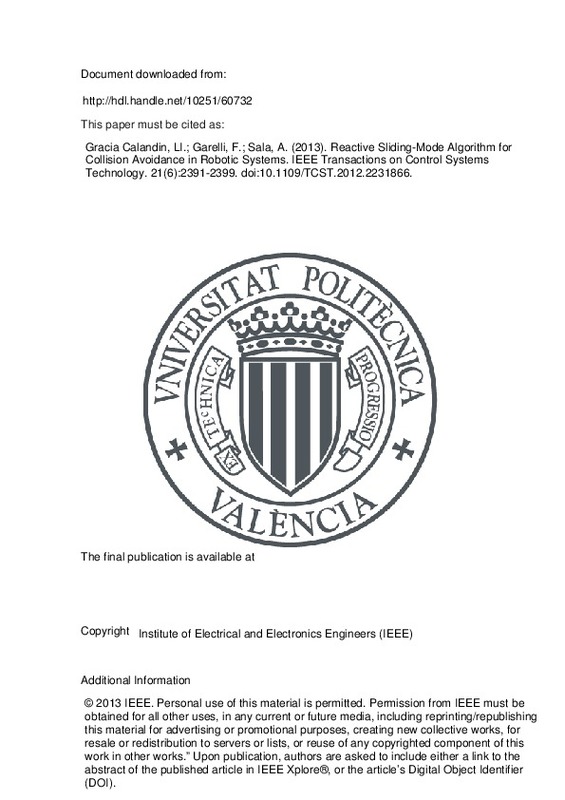JavaScript is disabled for your browser. Some features of this site may not work without it.
Buscar en RiuNet
Listar
Mi cuenta
Estadísticas
Ayuda RiuNet
Admin. UPV
Reactive Sliding-Mode Algorithm for Collision Avoidance in Robotic Systems
Mostrar el registro sencillo del ítem
Ficheros en el ítem
| dc.contributor.author | Gracia Calandin, Luis Ignacio
|
es_ES |
| dc.contributor.author | Garelli, Fabricio
|
es_ES |
| dc.contributor.author | Sala, Antonio
|
es_ES |
| dc.date.accessioned | 2016-02-09T11:23:29Z | |
| dc.date.available | 2016-02-09T11:23:29Z | |
| dc.date.issued | 2013-11 | |
| dc.identifier.issn | 1063-6536 | |
| dc.identifier.uri | http://hdl.handle.net/10251/60732 | |
| dc.description | © 2013 IEEE. Personal use of this material is permitted. Permission from IEEE must be obtained for all other uses, in any current or future media, including reprinting/republishing this material for advertising or promotional purposes, creating new collective works, for resale or redistribution to servers or lists, or reuse of any copyrighted component of this work in other works.” Upon publication, authors are asked to include either a link to the abstract of the published article in IEEE Xplore®, or the article’s Digital Object Identifier (DOI). | es_ES |
| dc.description.abstract | This brief presents a reactive reference conditioning algorithm for robot collision avoidance based on geometric invariance and sliding-mode (SM) ideas. First, constraints are defined in terms of the measurements given by the robot s sensors in order to guarantee that collisions will not occur. Then, a supervisory loop ensures the fulfillment of the constraints modifying the reference trajectory as much as necessary by means of a discontinuous control law. The proposed algorithm activates only when the constraints are about to be violated and, thus, in contrast to conventional SM approaches, there exists no reaching mode to the limit surface of the constraints (sliding surface). The validity and effectiveness of the proposed approach is substantiated by simulation and experimental results using a mobile robot equipped with infrared sensors. | es_ES |
| dc.description.sponsorship | This work was supported in part by research under Project DPI2011-27845-C02-01 (Spanish Government), Projects PAID-05-11-2640, and PAID-00-12-SP20120159, (Universitat Politecnica de Valencia, Spain), and Projects ANPCyT PICT-2011-0888, CONICET PIP 112-2011-00361, and UNLP I164 in Argentina. Recommended by Associate Editor M. Zefran. | en_EN |
| dc.language | Inglés | es_ES |
| dc.publisher | Institute of Electrical and Electronics Engineers (IEEE) | es_ES |
| dc.relation.ispartof | IEEE Transactions on Control Systems Technology | es_ES |
| dc.rights | Reserva de todos los derechos | es_ES |
| dc.subject | Collision avoidance | es_ES |
| dc.subject | Mobile robots | es_ES |
| dc.subject | Motion planning | es_ES |
| dc.subject | Reference conditioning | es_ES |
| dc.subject | Sliding-mode (SM) control | es_ES |
| dc.subject.classification | INGENIERIA DE SISTEMAS Y AUTOMATICA | es_ES |
| dc.title | Reactive Sliding-Mode Algorithm for Collision Avoidance in Robotic Systems | es_ES |
| dc.type | Artículo | es_ES |
| dc.identifier.doi | 10.1109/TCST.2012.2231866 | |
| dc.relation.projectID | info:eu-repo/grantAgreement/ANPCyT//PICT-2011-0888/AR/Sistemas conmutados de control. Aplicación al control de procesos y sistemas con restricciones/ | es_ES |
| dc.relation.projectID | info:eu-repo/grantAgreement/UPV//PAID-05-11-2640/ | es_ES |
| dc.relation.projectID | info:eu-repo/grantAgreement/UPV//PAID-00-12-SP20120159/ | es_ES |
| dc.relation.projectID | info:eu-repo/grantAgreement/MICINN//DPI2011-27845-C02-01/ES/ESTIMACION, OPTIMIZACION Y CONTROL MULTIVARIABLE EN SISTEMAS MULTI-MODELO/ | es_ES |
| dc.relation.projectID | info:eu-repo/grantAgreement/CONICET//PIP 112-2011-00361/ | es_ES |
| dc.relation.projectID | info:eu-repo/grantAgreement/UNLP//I164/ | es_ES |
| dc.rights.accessRights | Abierto | es_ES |
| dc.contributor.affiliation | Universitat Politècnica de València. Departamento de Ingeniería de Sistemas y Automática - Departament d'Enginyeria de Sistemes i Automàtica | es_ES |
| dc.description.bibliographicCitation | Gracia Calandin, LI.; Garelli, F.; Sala, A. (2013). Reactive Sliding-Mode Algorithm for Collision Avoidance in Robotic Systems. IEEE Transactions on Control Systems Technology. 21(6):2391-2399. https://doi.org/10.1109/TCST.2012.2231866 | es_ES |
| dc.description.accrualMethod | S | es_ES |
| dc.description.upvformatpinicio | 2391 | es_ES |
| dc.description.upvformatpfin | 2399 | es_ES |
| dc.type.version | info:eu-repo/semantics/publishedVersion | es_ES |
| dc.description.volume | 21 | es_ES |
| dc.description.issue | 6 | es_ES |
| dc.relation.senia | 254441 | es_ES |
| dc.identifier.eissn | 1558-0865 | |
| dc.contributor.funder | Ministerio de Ciencia e Innovación | es_ES |
| dc.contributor.funder | Universitat Politècnica de València | es_ES |
| dc.contributor.funder | Consejo Nacional de Investigaciones Científicas y Técnicas, Argentina | es_ES |
| dc.contributor.funder | Universidad Nacional de La Plata, Argentina | es_ES |
| dc.contributor.funder | Agencia Nacional de Promoción Científica y Tecnológica, Argentina | es_ES |







![[Cerrado]](/themes/UPV/images/candado.png)

